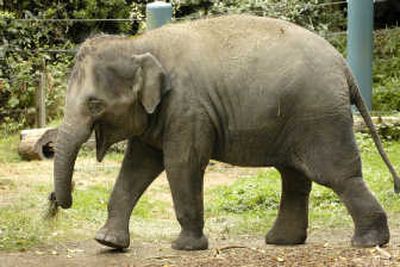Mystery surrounds Seattle elephant’s death

SEATTLE – The death of Hansa the elephant remains a mystery. Last week, preliminary necropsy results ruled out a host of illnesses in the sudden demise of the 6-year-old star of Woodland Park Zoo.
Hansa’s death set off public mourning in the city, and again raised questions about the advisability of keeping elephants in urban zoos.
Seattle residents have left flowers and bouquets of carrots at the zoo entrance. The memorial’s Web page for Hansa, www.zoo.org/hansa_memorial/index.html, rapidly filled with comments, some from Europe and Australia, but most from her hometown.
“Hansa brought such light and joy to our city!” reads one entry.
National animal rights groups such as People for the Ethical Treatment of Animals and In Defense of Animals of San Rafael, Calif., point to zoo conditions – the lack of space and inappropriate terrain – as likely factors in Hansa’s death and in the deaths of two other elephants who were euthanized in June, one in San Diego and one in Birmingham, Ala., as well as the 2006 death of the Los Angeles Zoo’s Gita.
“When you look at the life span of elephants the wild, they live into their 70s. In zoos, they are lucky to get through their 40s,” says Catherine Doyle of IDA. “Urban zoos simply don’t have enough space for these magnificent, intelligent animals.”
Doyle says that zoo elephants’ ills – chronic arthritis, foot ailments and even social problems like aggression – relate directly to the limited exercise space and lack of mental stimulation that zoo elephants get. Doyle’s group studies zoo elephants’ medical records, and many experts are in agreement with their conclusions.
But other experts see it differently.
Woodland Park’s Deputy Director Bruce Bohmky calls the limited-space argument simplistic and says that elephants in accredited zoos receive the best possible care.
“It’s not that (the IDA) doesn’t sometimes point out problems that need to be fixed in some smaller roadside zoos,” Bohmky says, “but in accredited zoos we are doing a good job.”
The American Zoo Association, the national accrediting body for zoos, filed a series of comments with the U.S. Department of Agriculture, the agency that regulates U.S. zoos, in December 2006.
“The overall health and foot health of these elephants is excellent. … On a 10-point scale, with 10 indicating the highest level of overall health, the average score for 284 elephants in AZA-accredited zoos was 8.74,” the report stated.
Bohmky says zoos and groups like IDA look at the elephants from a completely different perspective.
“IDA looks at each elephant individually, on a case-by-case basis, whereas we look at the survival of the species in the wild as a whole. That’s what we are working for. Our elephants are ambassadors – as zoos, we try to connect people in urban areas to nature, to animals they would otherwise never see. It’s hard to do that if nature isn’t there. That connection that people make at the zoo, with the elephants, or with other animals can motivate them to act, financially or politically.”
But for Doyle, the issue is clear-cut: “There can be no justification for keeping elephants in conditions that cause them to suffer and die prematurely,” she says.
Complete necropsy results on Hansa won’t be available for several weeks. The preliminary results released Friday represent about half of the tests that will be done. Colic, gastric torsion, genetic diseases, cancer and salmonellosis were eliminated as possible causes of death.
Hansa was the first elephant born at Woodland Park Zoo and in the state of Washington. Thousands of children entered the contest to name her, and hundreds waited in line to see her first appearance in the elephant exhibit. Her 5th birthday party was one of the zoo’s most attended events in recent years.
Though it has been a difficult few weeks at the zoo, Bohmky says that the public reaction to Hansa’s death has given the zoo direct proof that their mission is on track.
“We want to move people to care. The outpouring of support we’ve received from people in reaction to Hansa’s death shows that we are succeeding in spades,” he says.